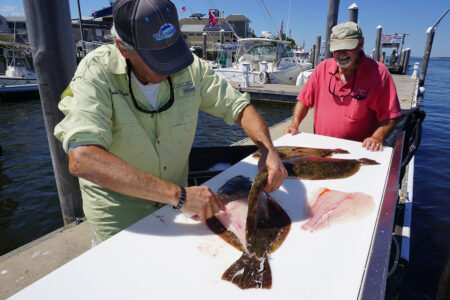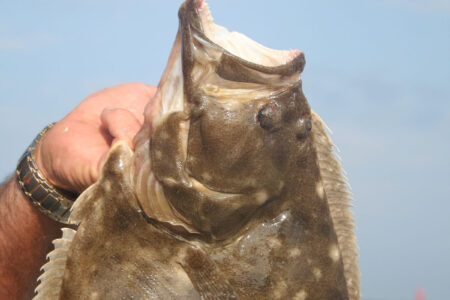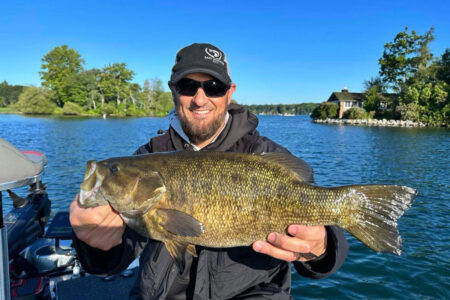
Striper fishing last year held, but the monsters never really showed.
For accomplished boat anglers who target big stripers with known methods in waters known to hold big bass—like Block Island today or Cuttyhunk in years back—I don’t think there is anything “accidental” about their results. For surfcasters, on the other hand, monsters stripers, say over 45 pounds, are often accidental. The determinate for these accidents is to live there and be out every night and catch a lot of stripers making few mistakes. If such a fish is one in a thousand, then you have to catch 1,000 and still might not have one. Those of us who caught many outrageously-large ones fished consistently all season and might still be waiting for their first “fifty.” Also, even today the only people who are taking big fish regularly are rod and reel commercials fishing from boats.
Remember that I count “fifties” each season and I see the same names year in and year out, and many are commercials. I know the names, even belonged to clubs with many of those guys. Sure, there will always be that no-brainer exception however rare. The fifties count reflects the success of the year classes 21-or-more-years before. Young-of-the-year surveys in Maryland for 1995 were about average at 8. While what was born could be an indication of the big fish swimming in front of us, we really know nothing about survival rates for a given year class so there are a great many unknowns at play here. Combined stock removal inflicted by sport and commercial pressure over all those years muddles both implied, even computed, year-class reduction. It could also be that there are as many big bass as ever but they were simply not caught. So many variables spring into the list of theories that it is impossible to predict results for a given year of counting.
The Count
Last year’s fifties catch was the lowest in the last 15 years of my tabulating the catches with only 24 such fish. This was consistent with the precipitous drop the year before, which was 42. Keep in mind that the highest fifties count ever recorded was 225 in 1967 with 25 from shore that year.
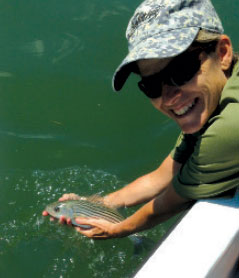
An interesting catch last year was a released monster bass in early June by angler Jolyn Wiggin. It was never weighed but measured out 51.75 inches fork with a 33-inch girth. Using the widely-used formula (Length x Girth Squared/800) it figured to be 70.44 pounds. Whatever the actual weight was, it had to be the best striper taken last season. There were four total bass over 60 reported in 2016; a 61.42 from a boat by Joe Mineo, another 60-plus by an angler unknown, and a 62-pounder in Delaware to go along with Jolyn’s awesome catch.
Surfcasters enjoyed a mild uptick with four fish from shore over 50 pounds last year. The first one was a bridge fish at New Jersey’s Corson’s Inlet in late May. Later in the season, the Cape Cod Canal produced a 50.8 in September. Still, the WOW generator was Fisherman Field Editor John Hanecak with two over the 50-pound mark; a 52 and a 54. John also hit the 50 list back in 2012. He had better paint his face and fish in cammies this coming season; I plan to hide in his bushes and follow him. I have only known one person to take two surf fifties in a season and that happened in 1969.
There are a lot of social issues in the study of fifties catches that muddy the count because anglers feel a lot of pressure to prove their angling prowess. I have never felt that the yield remained constant, and each season the change in count of such fish is influenced by a plethora of reasons: weather, discovery of monster contingents, angler knowledge, even grapevine activity, to say nothing of what is there and what was born 21 years before that might have survived the pressure of both sport and commercial pursuit.
Pipsqueaks Galore
The larger-than-normal year class of 2015 came north for the first time last season, and its effects were felt throughout the region. This spawn from the south, mostly Maryland, was the 8th highest on record in 2015; twice the mean average over the 60-year measurement results. Micro bass runs of 12- to 16-inch schoolies were reported from all over the striper coast. Maratha’s Vineyard, the Canal, the Maine coast and everywhere in-between saw them in robust numbers. Our Maine daughter, Susan, released as many as 20 such fish and had to move from them a number of times. My wife and I ran into them once in Narragansett Bay. Good signs.
Striper Spawn 2016
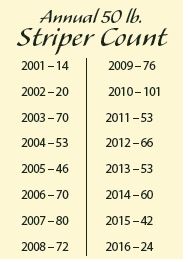 The official numbers are out on Maryland’s 2016 striped bass young-of-the-year, and they aren’t good. This late-summer count of striped bass born during the past spring is calculated annually by Maryland’s Department of Natural Resources by hauling a seine through essentially the same areas of Chesapeake Bay, at the same time, year after year. The number of baby bass caught in the net is averaged and a final count for the year is eventually calculated.
The official numbers are out on Maryland’s 2016 striped bass young-of-the-year, and they aren’t good. This late-summer count of striped bass born during the past spring is calculated annually by Maryland’s Department of Natural Resources by hauling a seine through essentially the same areas of Chesapeake Bay, at the same time, year after year. The number of baby bass caught in the net is averaged and a final count for the year is eventually calculated.
The 2016 results of 2.2 compares poorly to the long-term average of 11.86. In all fairness, striped bass spawning success in the Bay has historically varied considerably on a year to year basis. However, variability in spawning success is common in the long-term measurements in all the natal rivers. Spawning conditions—water temperature, river flow, clarity—all figure in to the fecundity of the fishery. Ultimately it’s how well those small fish fare over the next 21 years, regardless of how many were born on a given year that makes up our eventual 50-pounder potential.
Regular Stripers
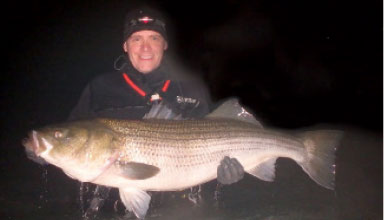
While we may count the monsters and young-of-the-year indices for the measurement of spawning success, the fishing in-between is a highly subjective mix of opinion and individual experience. Overall, reports seemed to provide the usual angling results of releasing decent stripers within the mix of available keepers. Other than the aforementioned horde of shorts, the mix in catch results was not appreciably different than other years. The one striper limit did not change the level of angling interest. I think the angling ethic has improved and less of the big breeders, which years before were killed, are being removed from the biomass. That is always a good thing!
| Young of the year |
|---|
|
On October 15, 2016, the Maryland Department of Natural Resources announced that the 2016 young-of-the-year striped bass index, a measure of bass spawning success in Maryland’s portion of the Chesapeake Bay is 2.2, well below the 63-year average of 11.7. The index represents the average number of less than 1 year old fish caught in 132 samples during the Juvenile Striped Bass Survey. Striped bass show great variability in spawning success from year-to-year. Occasional large year-classes are produced but are normally interspersed with average or below-average year-classes.
On average it takes a striped bass 21 years to achieve a weight of 50 pounds or more. Granted this can be skewed somewhat by variables such as available forage, disease and other environmental factors over the lifespan of an individual fish.
|
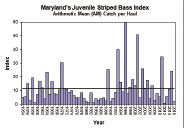 Survey results indicate that most anadromous species – fish that return to freshwater to spawn – experienced similarly low reproduction in 2016, potentially indicating that environmental factors such as dry weather and low river flows during the spring season may have contributed to the poor results. Intensive spring surveys found normal numbers of striped bass females on the spawning grounds however sensitive egg and larval stages often don’t survive adverse conditions.
Survey results indicate that most anadromous species – fish that return to freshwater to spawn – experienced similarly low reproduction in 2016, potentially indicating that environmental factors such as dry weather and low river flows during the spring season may have contributed to the poor results. Intensive spring surveys found normal numbers of striped bass females on the spawning grounds however sensitive egg and larval stages often don’t survive adverse conditions.